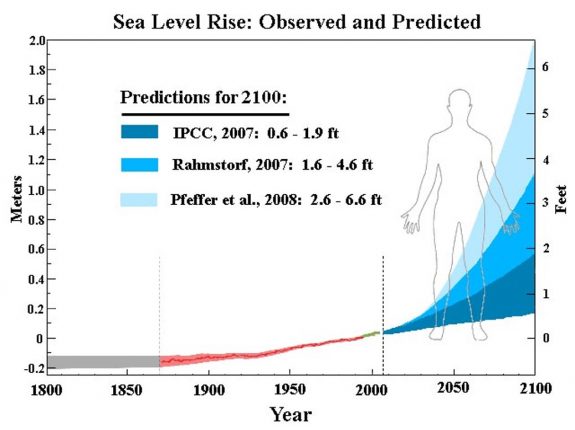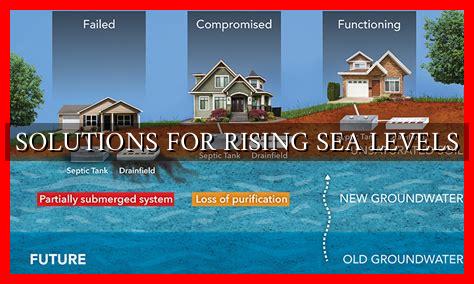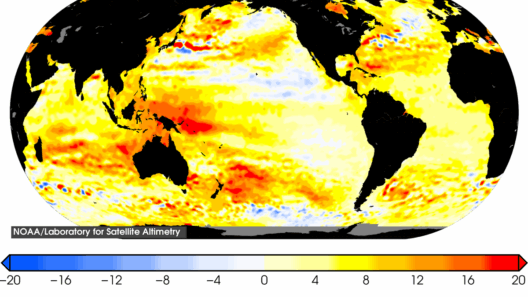The phenomenon of rising sea levels has become one of the most pressing environmental challenges of our time. As global temperatures continue to climb due to anthropogenic climate change, a significant transformation is occurring in the world’s oceans. Understanding how much sea levels are rising, the underlying causes, and the ramifications for human settlements and ecosystems is crucial in navigating this urgent issue.
Sea level rise refers to the increasing height of the ocean’s surface, influenced primarily by two key factors: thermal expansion of seawater as it warms and the melting of land-based ice, particularly glaciers and ice sheets. Studies indicate that global sea levels have been rising at an average rate of approximately 3.3 millimeters per year over the last several decades, with acceleration noted in recent years. This upward trend poses dire implications for coastal communities worldwide.
While the entire planet is affected, some regions face more acute threats than others. Low-lying areas, particularly deltas and coastal cities, are especially vulnerable. As sea levels continue to rise, these locations will experience increased flooding, saltwater intrusion, and erosion, leading to devastating impacts on infrastructure, ecosystems, and livelihoods.
The multifaceted nature of sea level rise also raises significant concerns regarding environmental justice. Marginalized communities often lack the resources to effectively combat or adapt to rising waters, exacerbating existing inequalities. Therefore, addressing sea level rise necessitates a comprehensive approach that incorporates social, economic, and ecological considerations.
A Deep Dive into Contributing Factors
There are several crucial factors contributing to the alarming rise in sea levels. The most pronounced driver is the thermal expansion of seawater. As average global temperatures rise, seawater expands. This thermal expansion accounts for approximately 50% of the increase in sea levels observed in the last century.
Another significant factor is the melting of ice. The Greenland and Antarctic ice sheets are experiencing drastic reductions in mass, contributing to the rising seas. Recent satellite measurements indicate that Greenland is losing ice at a rate of around 278 billion metric tons per year, while Antarctica is shedding ice at approximately 210 billion metric tons annually. These alarming statistics underscore the perilous trajectory of our planet’s climate system.
Moreover, the melting of glaciers around the world, from the Himalayas to the Andes, further exacerbates the situation. These once-stable ice masses serve as vital freshwater supplies for millions. As they diminish, water scarcity may become a pressing global issue, highlighting the interconnectedness of climate and resource management.
The Ominous Outlook for Coastal Regions
Coastal regions, where land meets the sea, are the frontline battlegrounds of sea level rise. Many of the world’s largest cities, including New York, Mumbai, and Bangkok, are situated in these vulnerable areas. A rise of just one meter could submerge vast expanses of land, displacing millions of people and reshaping geopolitical landscapes.
In addition to direct flooding, rising sea levels can lead to saltwater intrusion into freshwater supplies, jeopardizing drinking water availability and agricultural productivity. This intrusion can render once-productive farmland barren, forcing communities to relocate or adapt, often at significant economic and social costs.
The economic implications are staggering. Infrastructure damage and the costs of climate adaptation strategies can burden local governments and taxpayers. Insurance rates are expected to rise as risks increase, limiting home ownership and urban development in affected areas. Economies that rely heavily on tourism may also suffer due to the degradation of coastal ecosystems like coral reefs and beaches.
Global Response and Mitigation Strategies
As the threat of rising sea levels looms, collective action is imperative. International agreements like the Paris Accord seek to unite countries in an effort to reduce greenhouse gas emissions. Mitigation strategies include transitioning to renewable energy sources, enhancing energy efficiency, and promoting sustainable land use practices.
Adaptation measures are also critical. Communities must invest in resilient infrastructure, such as seawalls and tide gates, to protect against flooding. Restoration projects focused on natural barriers—like mangroves and wetlands—can offer protection while simultaneously supporting biodiversity and carbon sequestration.
Further, local and national governments must prioritize comprehensive planning that integrates climate change projections into urban development. Land-use policies should discourage construction in high-risk flood zones and promote the rehabilitation of natural landscapes to absorb floodwaters.
Education and community engagement are equally vital for fostering resilience. Public awareness campaigns about the realities of sea level rise can empower individuals to take part in local adaptation efforts. Grassroots initiatives often yield innovative solutions tailored to local contexts, which can significantly bolster community preparedness.
A collaborative and multifaceted approach is not merely prudent—it is essential for averting the perilous consequences of rising seas. As scientific research evolves and global cooperation strengthens, the hope remains that informed action can mitigate this existential threat.
Ultimately, addressing sea level rise is not just an environmental concern; it is an opportunity for humanity to demonstrate its capacity for resilience and adaptation in the face of overwhelming odds. The future will depend on our collective commitment to safeguarding the planet for generations to come.








